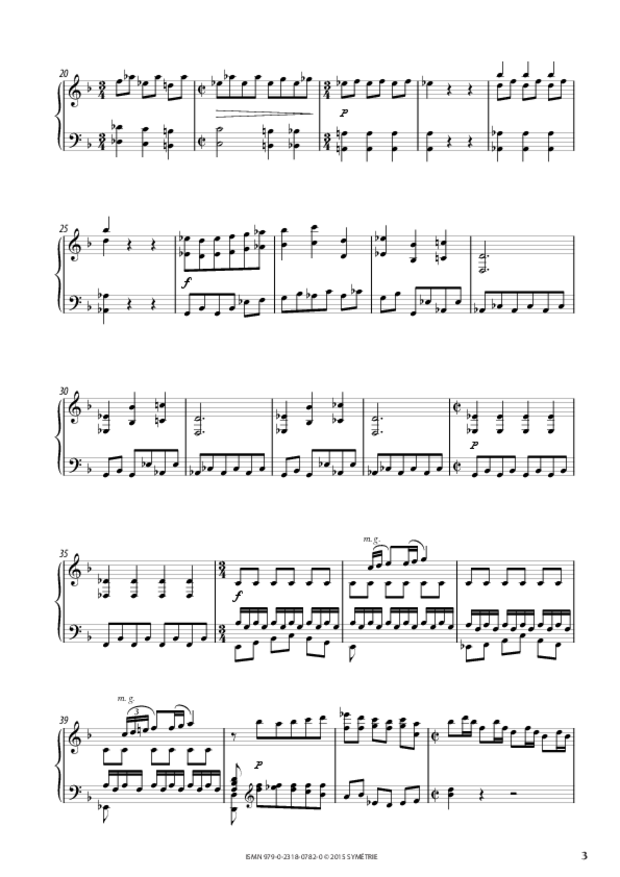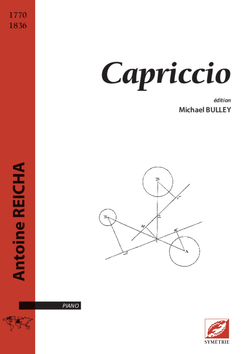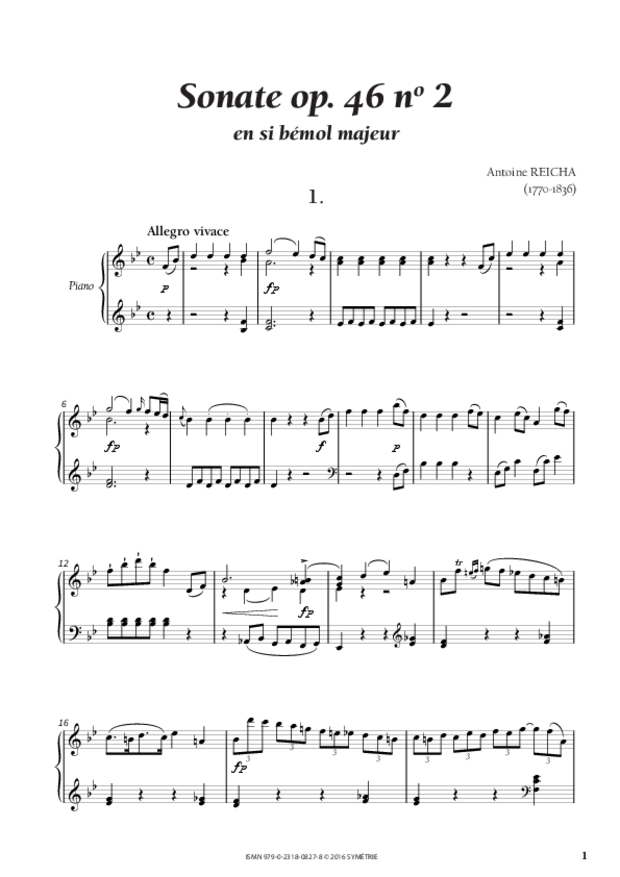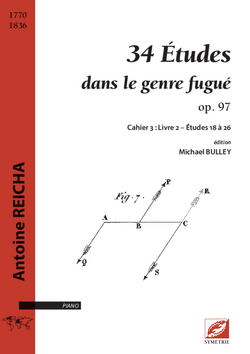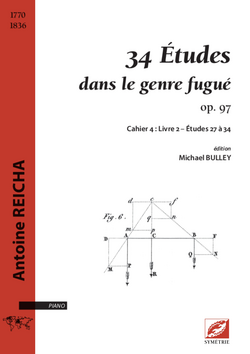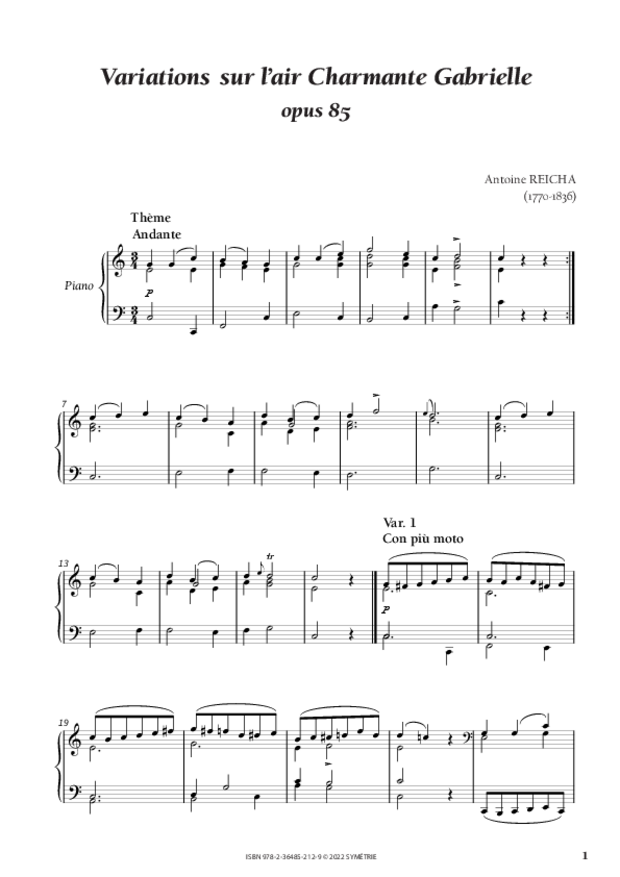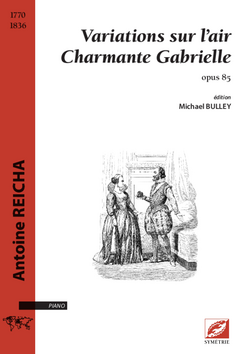This edition of the work entitled 34 Études dans le genre fugué (34 Studies in Fugal Style), which we are publishing in four parts, is based on that published in Paris, in two volumes of 17 studies, in 1820, by Érard. That edition begins with a preface written by the composer, followed by 16 remarks on certain of the studies. We have reproduced that preface and those remarks in the present edition. The work was reissued in 1840 by Schonenberger under the title La Fugue et le Contrepoint mis en pratique et appliqués au Clavier du Piano (Fugue and Counterpoint put into practice and applied to the piano keyboard). Apart from one error of key signature, the notation is identical to that of the 1820 edition. The only important difference is that the remarks are placed next to the study they refer to.
Just like the preludes and fugues of J. S. Bach’s Well-Tempered Clavier, each study consists of two parts, the second of which is, in the great majority of cases, a fugue or, at least, fugal in style. In 24 of the studies, the two parts are in exactly the same key; in the others, one is the major or minor of the other. Unlike that of Bach’s work, the sequence of keys here does not seem to have any particular structure.
The title of this collection presents something of a mystery, for at first sight we seem to have, almost every time, a study that is not fugal, followed by a fugal piece that is not a study. In his preface, however, Reicha makes it clear that the term “fugal style” covers the whole work, and his preliminary remarks also indicate that the first pieces of each pair have characteristics that, for him, are integral to that concept. In his remarks, Reicha uses the term “fugue” of twelve of the pieces and gives advice about composition in that form, but in the preface he consistently employs the expression “fugal style” rather than the word “fugue”, even though his remarks clearly apply to fugues. One of the subtitles of the original edition is “for the use of young composers.” Did Reicha then mean that these fugues were not for learning the rules of the form, but for giving these “young composers” ideas for the composition of a fugue that, to avoid the possible censure of their teachers, they will call “piece in fugal style” rather than “fugue”? The term “study” is usually applied to a piece that demonstrates a particular aspect of composition or technique, but if we take into account some of the philosophical ideas Reicha expresses in his various treatises, perhaps we should consider this work, not as a collection of 34 individual studies, but rather as a general study of writing in fugal style.
Whatever may have prompted Reicha to adopt this slightly misleading title for his work, we are here far removed from the idea of a study as a technical exercise. This collection is full of surprises, including simple airs, canons, variations, harmonic sequences that seem to conjure up a romantic spirit of the 20th century rather than of the 19th, even church bells, and, of course, a great variety of fugues.
The remarks that precede the studies seem to us to lack the engagement normally to be found in Reicha’s writings, such as the commentaries that accompany the collection of piano pieces called Practische Beispiele. Having presented this work as “studies”, Reicha may have felt obliged to comment on it in a pedagogical way. So, although they have a certain historical interest, these remarks by the composer do not really give an idea of the freshness and invention of the music that follows.
As for collections of fugues for piano by Reicha, we have three: the 36 Fugues of 1803, which Beethoven dismissed with the words “The fugue is no longer a fugue”, the 6 Fugues of 1810, and these of the 34 Études, opus 97. We know of only one fugue for piano that Reicha might have written after those of this last collection. It appears in his Traité de haute composition musicale, published in 1824, and is an annotated example, having the title Fugue instrumentale à 3, dans le style moderne (Three-part instrumental fugue, in the modern style). We should like to suggest therefore, though without any certainty, that the last piece of the 34 Études is the last fugue for piano that Reicha wrote purely to be played. The theme is broad and noble. Towards the end, it contains a range of techniques typical of fugal form – stretto, augmentation, diminution, but there is nothing complicated about the ending: it is just a dominant seventh chord resolved to the tonic, as if, with this goodbye to the fugue for piano, Reicha is saying “That’s it! That’s music.”
Press reviews
Over a hundred of Reicha’s compositions have been published and a great number still remain in manuscript, among which many are of the highest importance to the art of music.
Hector Berlioz, Journal des Débats, 3 July 1836
That the whole of this collection of studies by Reicha will now be available to pianists, thanks to the remarkable work of the editor, Michael Bulley, is a genuine musical landmark.
Daniel Blackstone, L’Éducation musicale
Audio Excerpts

Étude 1 : Introduction, Poco andante
Étude 1 : Allegro
Étude 4 : Air – Lento
Étude 4 : Allegro e sempre legato
Étude 6 : Poco allegretto
Étude 6 : Allegro
Étude 9 : Lento
Étude 9 : Allegro
Contents
- 1 – Étude 1
- 2 – Étude 2
- 3 – Étude 3
- 4 – Étude 4 – Air
- 5 – Étude 5 – Air
- 6 – Étude 6
- 7 – Étude 7
- 8 – Étude 8
- 9 – Étude 9
Nomenclature
piano
